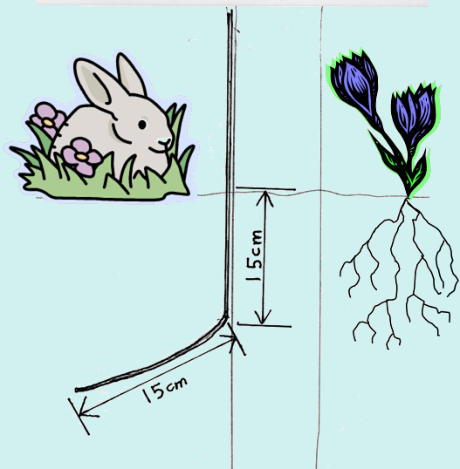
© Garden Cottage Nursery, 2022

Protecting against rabbits and
other browsing mammals
Rabbits

For many people their gardening efforts are repeatedly frustrated by the attention of ravenous
hordes of rabbits. With a few alterations and some careful planning the Lagomorphic tide can
be turned.
Rabbits and hares are very effective plant destroying machines, not merely eating enough to get-by, their insatiable appetite for
new things and destruction causes much damage throughout the garden.
Speculative chewing of nearly everything to find what tastes best, the uprooting of new plants, the stripping of bark from trees, and
of course digging holes in your lawn for you to turn your ankle in, all make rabbits many gardener’s most hated enemy.
So what can be done?
You could find a good recipe for rabbit stew, get an air rifle or ferret and go on a spree, though as everyone knows nothing breeds
quite like rabbits and in most locations new bunnies will soon move in to replace the killed ones.
The best long-term answer to a rabbit problem is to protect your garden as best as is practicable by fencing.



Erecting a rabbit-proof fence is a time consuming process and
hard work involving a lot of digging, but it is still the best way
to protect your garden where total rabbit eradication is not an
option.
A chain is only as strong as it’s weakest link and a rabbit-proof
fence is not rabbit-proof if it does not entirely surround the
garden. Rabbits are small, flexible and wily creatures just
waiting to exploit any chink, so check the fence regularly and
patch holes.
Rabbits and especially hares are accomplished jumpers so
any fence should be 4’-5’ (120-150cm) high above ground, of
a galvanised hexagonal mesh with gaps of not more than 1”
(25mm) in diameter. The tricky and time consuming bit is the
digging down to sink the bottom 1’ (30cm) of the fence into
the ground, bending the lower 6” (15cm) outwards to
discourage them burrowing into your green and pleasant land.
The posts need not be as stout or as deeply driven as a stock
or deer fence, but you still don’t want it to fall over! Round 2”
(5cm) posts at 7-10’ (2-3m) spacing should do, though thicker
post will last longer.


Where fencing and eradication is not a practical option one must learn to live with the rabbits and to garden with them in mind.
Flower beds may be somewhat protected by small enclosures of fencing.
For individual trees tree guards may be used, these are available in several designs, all ugly. They form a cylinder of mesh or solid
plastic around the trunk to keep the rabbits and hares out, other designs work by wrapping a stiff self-expanding spiral of plastic
around the trunk of your young tree to prevent ring barking.
There is probably no such thing as a truly rabbit-proof plant, they will usually try something before deciding they don’t like it. Hares
are particularly selective eaters and by careful avoidance of planting rabbit fodder and sticking to that which is poisonous or
unpalatable something resembling a garden can emerge.
Where a rabbit visitation is an occasional rather than frequent event using a good number of rabbit-resistant plants in the most
accessible areas of the garden may well be more sensible than spending lots of time and money on a fence.
We have come across many lists of so-called rabbit and deer-proof plants in our time and for nearly every plant on those lists
someone has told us how the rabbits, hares, sheep or deer always make a bee-line for it. Still there are plants that are definitely
preferred over others, different populations are reputed to have different tastes so what works in some places may not be so
effective elsewhere. Some of these resistant plants are toxic to humans too, so parents and grandparents with little people
running around might also wish to avoid them.
Below is a fairly long list of the plants less likely to be bothered by rabbits and other grazers, all will generally grow well in Wester
Ross, though some will want some shelter from salt winds.
Members of the iris family, Iridaceae, are pretty much disliked by everything, so irises themselves, Crocosmia and Libertia are
worth a go, many of the buttercup family, Ranunculaceae are poisonous or inedible so try Aconitum, Anemone or Clematis.





© Garden Cottage Nursery, 2021

Protecting against rabbits and
other browsing mammals
Rabbits

For many people their
gardening efforts are
repeatedly frustrated by the
attention of ravenous hordes
of rabbits. With a few
alterations and some careful
planning the Lagomorphic
tide can be turned.
Rabbits and hares are very effective plant destroying machines,
not merely eating enough to get-by, their insatiable appetite for
new things and destruction causes much damage throughout
the garden.
Speculative chewing of nearly everything to find what tastes
best, the uprooting of new plants, the stripping of bark from
trees, and of course digging holes in your lawn for you to turn
your ankle in, all make rabbits many gardener’s most hated
enemy.
So what can be done?
You could find a good recipe for rabbit stew, get an air rifle or
ferret and go on a spree, though as everyone knows nothing
breeds quite like rabbits and in most locations new bunnies will
soon move in to replace the killed ones.
The best long-term answer to a rabbit problem is to protect your
garden as best as is practicable by fencing.



Erecting a rabbit-proof fence is a time consuming process and
hard work involving a lot of digging, but it is still the best way to
protect your garden where total rabbit eradication is not an
option.
A chain is only as strong as it’s weakest link and a rabbit-proof
fence is not rabbit-proof if it does not entirely surround the
garden. Rabbits are small, flexible and wily creatures just
waiting to exploit any chink, so check the fence regularly and
patch holes.
Rabbits and especially hares are accomplished jumpers so any
fence should be 4’-5’ (120-150cm) high above ground, of a
galvanised hexagonal mesh with gaps of not more than 1”
(25mm) in diameter. The tricky and time consuming bit is the
digging down to sink the bottom 1’ (30cm) of the fence into the
ground, bending the lower 6” (15cm) outwards to discourage
them burrowing into your green and pleasant land. The posts
need not be as stout or as deeply driven as a stock or deer
fence, but you still don’t want it to fall over! Round 2” (5cm)
posts at 7-10’ (2-3m) spacing should do, though thicker post will
last longer.


Where fencing and eradication is not a practical option one
must learn to live with the rabbits and to garden with them in
mind.
Flower beds may be somewhat protected by small enclosures
of fencing.
For individual trees tree guards may be used, these are
available in several designs, all ugly. They form a cylinder of
mesh or solid plastic around the trunk to keep the rabbits and
hares out, other designs work by wrapping a stiff self-expanding
spiral of plastic around the trunk of your young tree to prevent
ring barking.
There is probably no such thing as a truly rabbit-proof plant,
they will usually try something before deciding they don’t like it.
Hares are particularly selective eaters and by careful avoidance
of planting rabbit fodder and sticking to that which is poisonous
or unpalatable something resembling a garden can emerge.
Where a rabbit visitation is an occasional rather than frequent
event using a good number of rabbit-resistant plants in the most
accessible areas of the garden may well be more sensible than
spending lots of time and money on a fence.
We have come across many lists of so-called rabbit and deer-
proof plants in our time and for nearly every plant on those lists
someone has told us how the rabbits, hares, sheep or deer
always make a bee-line for it. Still there are plants that are
definitely preferred over others, different populations are
reputed to have different tastes so what works in some places
may not be so effective elsewhere. Some of these resistant
plants are toxic to humans too, so parents and grandparents
with little people running around might also wish to avoid them.
Below is a fairly long list of the plants less likely to be bothered
by rabbits and other grazers, all will generally grow well in
Wester Ross, though some will want some shelter from salt
winds.
Members of the iris family, Iridaceae, are pretty much disliked
by everything, so irises themselves, Crocosmia and Libertia are
worth a go, many of the buttercup family, Ranunculaceae are
poisonous or inedible so try Aconitum, Anemone or Clematis.



















